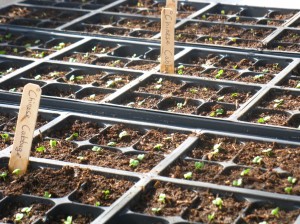Here’s the first calf of 2013 born April 16. A young bull calf born to a first-calf heifer. The birth went very smoothly and the calf was up walking and nursing within 30 minutes.
Here’s the first calf of 2013 born April 16. A young bull calf born to a first-calf heifer. The birth went very smoothly and the calf was up walking and nursing within 30 minutes.
Planting for the spring/summer season lasts about 3 months. Cooler weather crops such as cabbage, lettuce, carrots, and broccoli are seeded and transplanted starting in mid February. We plant in stages in order to spread out the harvest so we’re still planting some warm weather crops in mid May. The first photo shows leeks being transplanted, the second shows seeding of cucumber.
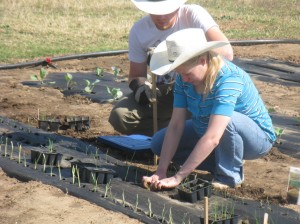
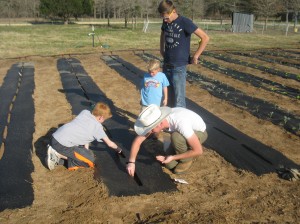
Here’s a view back over the recently planted rows – with the cattle grazing in the distance. The final photo is of more seedlings in the ‘hardening off’ stage where they are exposed to wind and some sun for about a week so there is less transplant shock.
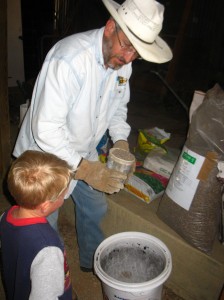 The first few rows of the garden were amended for mineral deficiencies last year. So the next step is preparing and spreading organic fertilizer. We measured and marked off the rows and planted the first rows before our order of plastic mulch arrived.
The first few rows of the garden were amended for mineral deficiencies last year. So the next step is preparing and spreading organic fertilizer. We measured and marked off the rows and planted the first rows before our order of plastic mulch arrived.
On all the other rows, plastic mulch is placed on top of the drip tape. The plastic is an excellent weed barrier and also limits evaporation so we don’t have to irrigate very much.
We track everything on spreadsheets showing dates for seeding, transplanting, and expected harvest as well as row locations for each variety planted.
Late January, work began on the new garden expansion. Our family garden of the past has great fertile soil but is too small for the vision of growing a surplus to sell. The expansion is in a bermudagrass pasture so we begin with discing and then raking out the grass runners.
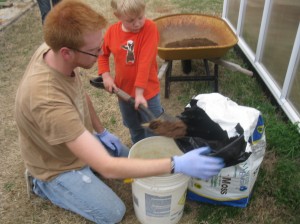 Mid January is the time to start seeds in the greenhouse for tomatoes and peppers we hope to harvest in June! We’re also starting a variety of cool weather crops such as cabbage, broccoli, and leeks.
Mid January is the time to start seeds in the greenhouse for tomatoes and peppers we hope to harvest in June! We’re also starting a variety of cool weather crops such as cabbage, broccoli, and leeks.
We make our growing medium by mixing compost and peat moss. Several seed trays are filled and the team carefully places the seeds at the correct depth.
With the dozens of varieties we are growing, each having two or three planting dates, we track everything with spreadsheets. The light soil and heat in the greenhouse make watering once or twice a day mandatory.
This was our first year to start seeds in the greenhouse so it was a great joy to see them all quickly germinate and grow. On many nights the outside temperature dipped to near or below freezing so we used a small heater (visible above to the right of the watering jug) to keep temperatures inside the greenhouse a few degrees warmer.
